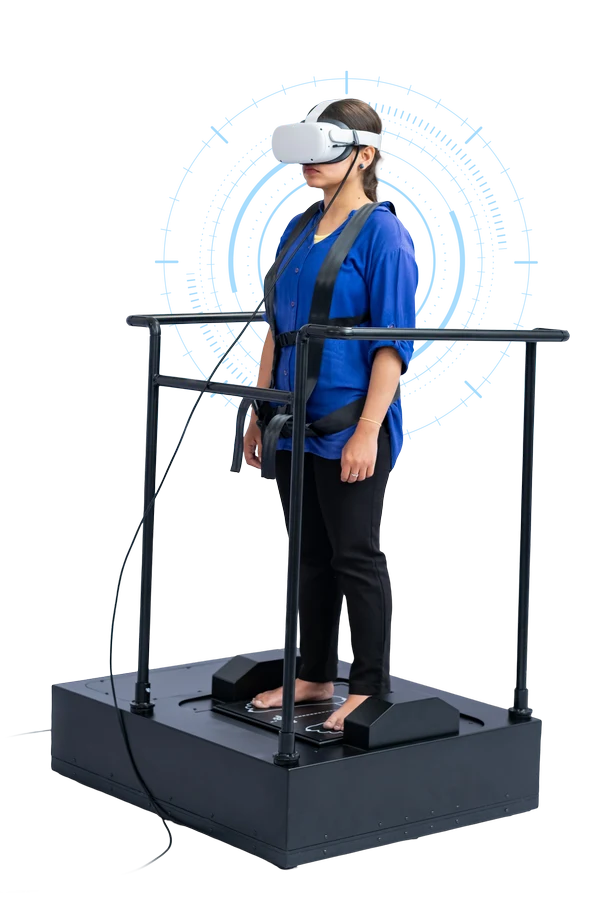






NeuroEquilibrium CDP offers a thorough and precise method for assessing and treating balance disorders, ensuring effective diagnosis and personalized rehabilitation strategies.
Before you start your CDP test, put on clothes that are comfortable and don’t have heels. Try not to have caffeine atleast a few several hours ahead of your test, mainly if it’s late in the day. If you are taking drugs that might affect your balance, tell your doctor. The test is not painful because you stand on a platform that rocks gently as you’re fitted in a safety harness.
As you take the test, you will stand on a platform that moves slightly and do simple tasks. You may sometimes need to take notice of something and look at it, or look away when the environment gets too busy. The purpose of the test is to see how your vision, inner ear, and muscles team up to keep you balanced. The entire time, you will be clipped in to a harness to keep you safe from falling.
The tests show how effectively your body’s balance systems help you hold your balance. If a system isn’t performing correctly, the test will find out which one it is. This way, your doctor can understand your situation condition well and recommend the best treatment.
CDP helps find out which areas of your balance system are not working correctly. With the help of your results, therapists are able to choose exercises that focus on your weak areas. If you do these exercises regularly, they will make you more balanced, less dizzy, and protect you from falling.
After the test, your therapist will create a custom rehabilitation plan just for you. This may include exercises to boost your coordination, strength, and stability. With consistent sessions and effort, your balance can improve significantly, helping you feel more steady and confident in your movements.
Corporate Office:
140, Shrigopal Nagar, Gopalpura Bypass Road, Jaipur 302018, Rajasthan, India
Manufacturing Site:
1st Floor, Plot No.3, Pooja Tower, Muktanand Nagar, Gopal pura Mode, Jaipur, Rajasthan 302018
All rights reserved © 2024 NeuroEquilibrium Diagnostic Systems Pvt Ltd.
Vertigo Clinic in Ujjain | Vertigo Clinic in Barwani | Vertigo Clinic in Patna | Vertigo Clinic in Miraj | Vertigo Clinic in Kolhapur | Vertigo Clinic in Nashik | Vertigo Clinic in Jaysingpur | Vertigo Clinic in Amravati | Vertigo Clinic in Solapur | Vertigo Clinic in Pune | Vertigo Clinic in Aurangabad | Vertigo Clinic in Nagpur | Vertigo Clinic in Sagar | Vertigo Clinic in Indore | Vertigo Clinic in Jabalpur | Vertigo Clinic in Bhopal | Vertigo Clinic in Bilaspur | Vertigo Clinic in Ahmedabad | Vertigo Clinic in Vadodara | Vertigo Clinic in Surat | Vertigo Clinic in Navi Mumbai | Vertigo Clinic in Thane | Vertigo Clinic in Mumbai | Vertigo Clinic in Palghar | Vertigo Clinic in Jaipur | Vertigo Clinic in Sriganganagar | Vertigo Clinic in Alwar | Vertigo Clinic in Kota | Vertigo Clinic in Udaipur | Vertigo Clinic in Lucknow | Vertigo Clinic in Prayagraj | Vertigo Clinic in Varanasi | Vertigo Clinic in Gurgaon | Vertigo Clinic in Dehradun | Vertigo Clinic in Rohtak | Vertigo Clinic in Amritsar | Vertigo Clinic in Ludhiana | Vertigo Clinic in Greater Noida | Vertigo Clinic in Delhi | Vertigo Clinic in Kannur | Vertigo Clinic in Trichur | Vertigo Clinic in Cochin | Vertigo Clinic in Coimbatore | Vertigo Clinic in Tiruppur | Vertigo Clinic in Chennai | Vertigo Clinic in Hosur | Vertigo Clinic in Bangalore | Vertigo Clinic in Mangalore | Vertigo Clinic in Hyderabad | Vertigo Clinic in Sangli